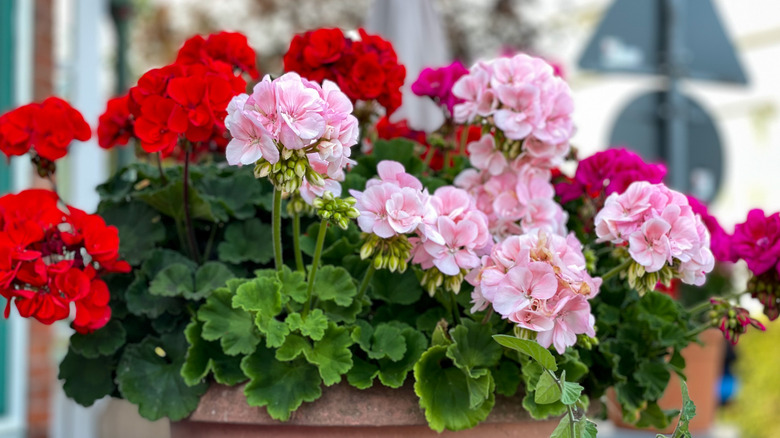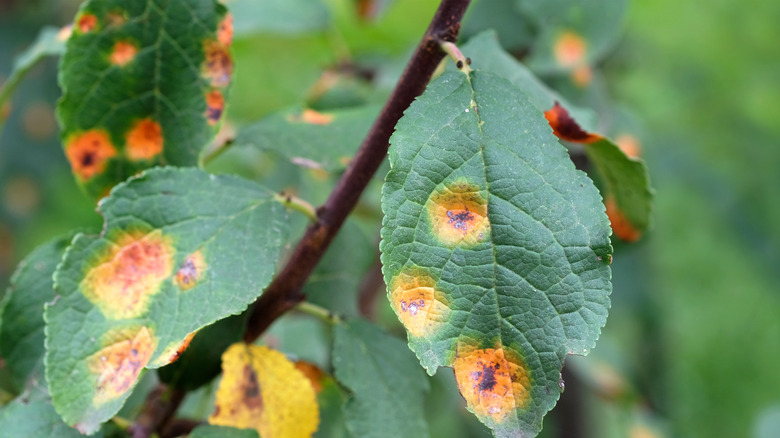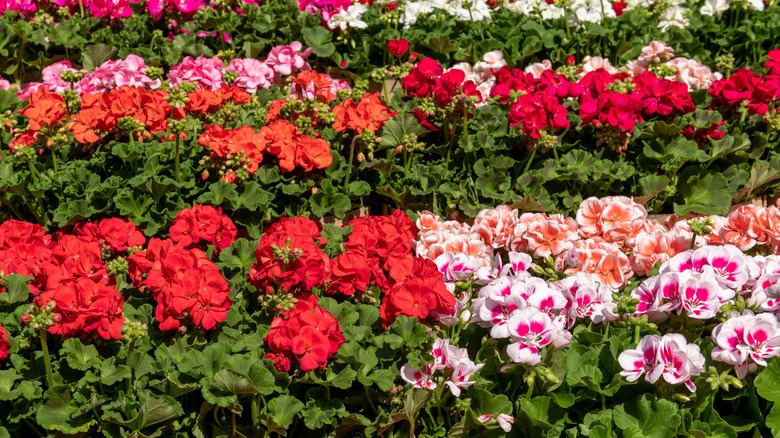Plant Rescue: What Rust On Geraniums Looks Like And How To Save Them
Geraniums are annual flowers with full, colorful, and scented blooms that are very popular in spring in summer. They come in plenty of varieties, including simple color variants, the trailing ivy-leafed geranium, and the popular spectrum of scented-leaf geraniums, including lemon, rose, peppermint, apple, and most popular, citronella, also known as the mosquito plant (via Clemson Cooperative Home & Garden Information Center).
The beautiful flowers are quite easy to grow and maintain during their bloom cycle, requiring only four hours of direct sun a day, regular watering, and occasional fertilization to keep nitrogen levels up. The only major task for geranium care and maintenance is deadheading them, which refers to the process of pinching off dead blooms to make room for new ones. That being said, geraniums are not invulnerable to common pests and diseases, including rust. Keep reading to learn how to both identify rust on your geraniums and help cure them.
How to tell if your geranium has rust
When you think of rust, you likely don't think of your plants and flowers. Rust on plants is not the same thing as rust on metal or machinery, though. According to the University of Minnesota Extension, rust actually refers to a fungal disease named for the rust color that grows on affected leaves and flowers.
Ortho says that rust grows on plants because of excessively wet conditions and humidity. Specifically, they identify watering your plants on the actual leaves or flowers as opposed to the base can help contribute to rust development and growth. From there, the disease eats away at the plant, and while it isn't actually fatal on its own, it can weaken your geraniums and make them susceptible to other diseases. It can also spread between plants from wind blowing the spores around and shared weeds.
You likely won't be able to find rust on the actual flowers of your geraniums, but a good way to see that rust has taken hold is if the blooms look a little dull or lifeless without another cause. The rust fungus will grow anywhere green, so if you don't see it on the main leaves of your geraniums, check underneath and on the stems. The rust pores will also leave a powdery residue on your hands, which is a good way to confirm it is rust you're dealing with.
How to get rid of rust
If you've identified rust on your geraniums, don't panic. The good news is that rust is not fatal on its own. Rust is more of an aesthetic concern than anything, although it can eat away at your geraniums' foliage and make it susceptible to other diseases if not treated soon after discovery.
The University of Minnesota Extension says the first thing you should do to treat rust is simply remove the affected leaves, as long as it's no more than a third of the geraniums' total foliage. If the flower has a pretty serious rust problem, you should either dig it up or relocate its pot to an isolated area, so others aren't infected while it heals. Remove leaves as you see them, making sure you don't throw them away close enough to your garden that spores could regrow.
The Royal Horticultural Society also warns that excessive nitrogen levels could lead to rust growth. Geraniums need lots of nitrogen to grow full and lush, so be careful not to go overboard. They also note that fungicides aren't safe for crops with rust, but they're fine for flowers like geraniums. Look for products with the chemicals tebuconazole, a combination of tebuconazole with trifloxystrobin, or triticonazole. Dre Campbell Farm also recommends either baking soda or neem oil. Also, take care not to overwater or overcrowd your geraniums, which can create overly humid and wet environments where rust thrives.


